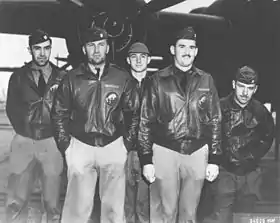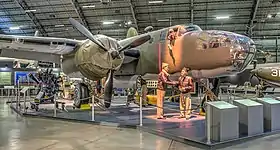William John Dieter
William ‘Billy Jack’ Dieter (October 5, 1912 – April 18, 1942) was a sergeant in the United States Army Air Corps. Dieter was a bombardier on the Green Hornet, the sixth plane to take off from a US carrier as part of the Doolittle Raid, a bold long-range retaliatory air raid on the Japanese main islands, on April 18, 1942, four months after the attack on Pearl Harbor. The attack was a major morale booster for the United States. Dieter was one of only three airmen to die in the raid itself, when his B-25 Mitchell, 'Green Hornet', crashed on the coast of China, having run out of fuel.
William John Dieter | |
|---|---|
 | |
| Nickname(s) | "Billy Jack" |
| Born | October 5, 1912 Vail, Iowa, U.S. |
| Died | April 18, 1942 (aged 29) Coast of China near Shipu |
| Buried | |
| Allegiance | |
| Service/ | United States Army United States Army Air Corps United States Army Air Forces |
| Years of service | 1936–1942 |
| Rank | Staff Sergeant |
| Unit | 95th Bomb Squadron 17th Bomb Group |
| Battles/wars | World War II • Doolittle Raid (KIA) |
| Awards | Distinguished Flying Cross Purple Heart |
Early life and education
Dieter was born on October 5, 1912, in Vail, Iowa, to Jesse T. Dieter and Mary McCalpin Dieter. After living in Vail, the family moved to South Dakota, Potosi, Missouri, and eventually, Tulelake, California. Dieter attended only one year of high school.
Military career
Dieter then enlisted in the Field Artillery on October 29, 1936, at Vancouver Barracks in Washington. Dieter served a three year term, then left the Army. After finding it difficult to find work, Dieter enlisted in the United States Army Air Corps on December 12, 1940.
Dieter was trained as a bombardier, and served as a Douglas B-18 Bolo and North American B-25 Mitchell bombardier with the 95th Bomb Squadron of the 17th Bomb Group at McChord Field in Washington, and then at Pendleton Field in Oregon, until he was selected for the mission to be led by James Doolittle in February 1942.[1]
Doolittle Raid

In early 1942, then lieutenant colonel James Doolittle volunteered for and received General H.H. Arnold's approval to lead the top secret attack of 16 B-25 medium bombers from the aircraft carrier USS Hornet, with targets in Tokyo, Kobe, Yokohama, Osaka and Nagoya.

After training at Eglin Field and Wagner Field in northwest Florida, Dieter and the other volunteer flight crew members proceeded to McClellan Field, California for aircraft modifications at the Sacramento Air Depot, followed by a short final flight to Naval Air Station Alameda, California for embarkation aboard the aircraft carrier USS Hornet.
On April 18, 16 North American B-25 Mitchell crews took off from the Hornet, reached Japan, and bombed their targets. Dieter was the bombardier in the sixth plane, the 'Green Hornet', piloted by 1st Lt. Dean E. Hallmark and 2nd Lt. Robert J. Meder
While one crew chose to land in Russia due to their bomber's unusually high fuel consumption, the other fifteen planes then headed for their recovery airfields in China. Most of the other crewmen who participated in the one-way mission bailed out over China when their B-25s ran out of fuel; however, the Green Hornet crashed near the coast of China. Dieter and fellow crew member S/Sgt. Donald E. Fitzmaurice, drowned in trying to swim to shore (possibly due to internal injuries suffered in the crash), while the other three crew members of the 'Green Hornet' were captured shortly afterwards by the Japanese.
The following is an excerpt from a letter written in August, 1945, by Earl L. Deiter, S.J., (Capt) Chaplain, U.S. Army.[2] Note that all spelling, capitalization, and punctuation is "as is" in the original.
- "1st. Lt. Dean E. Hallmark was pilot of the plane on which Lt. Neilson was Navigator and Bill[3] was Bombadier. They flew from the Hornet directly over Tokyo and Bill dropped his bombs 100% on his target, a large steel mill. The pilot headed for China, and at about 8:30 the night of April 18, 1942, while flying very low over the water, he noticed the gas tanks were empty and gave the order to prepare to crash. Hardly had the order been given, and without much preparation, (when?[4]) the plane crashed into the sea, just a few hundred yards from the coast. Bill was riding in the nose of the plane, and when the plane crashed, the nose was broken open, apparently swooping Bill out of the plane. Capt. Nielson[5] said that when he got out of his position, Bill was already standing on top of the plane, and that he said, "I am hurt all over". They all adjusted their life belts, and started swimming to shore. Lt. Hallmark was helping Corporal Donald Fitzmaurice of Lincoln, Neb., and someone was helping Bill. When Lt. Neilson reached shore he said he was exhausted and collapsed. On awakening the next morning, he saw the bodies of Bill and Corp. Fitzmaurice which had washed ashore. Upon examing the body of Bill carefully, he noticed quite a few bruises which obviously hindered Bill from swimming and staying afloat, but apparently he became exhausted while still in the water and no doubt drowning was the cause of his death."
- "The shore where the accident took place was at the foot of a little village of 300 or 400 people, named Shipu, which in turn was about 20 or 30 miles south of Ningpo. Any large map of China will show the town of Ningpo. The native Chinese built a coffin for Bill and Fitzmaurice, and buried the both of them just over a little knoll a few yards back from the shore where the accident happened."
As noted in the letter, Dieter was originally interred at Shipu, China by Chinese civilians near the site of the crash. His body was returned to the States for reburial after interment at Schofield Barracks, Mausoleum #2 in Oahu, Hawaii. In 1949, his body was relocated permanently to Golden Gate National Cemetery.
Legacy

The Doolittle Raid is viewed by historians as a major morale-building victory for the United States. Although the damage done to Japanese war industry was minor, the raid showed the Japanese that their homeland was vulnerable to air attack, and forced them to withdraw several front-line fighter units from Pacific war zones for homeland defense. More significantly, Japanese commanders considered the raid deeply embarrassing, and their attempt to close the perceived gap in their Pacific defense perimeter led directly to the decisive American victory at the Battle of Midway in June 1942.
When asked from where the Tokyo raid was launched, President Roosevelt coyly said its base was Shangri-La, a fictional paradise from the popular novel Lost Horizon. In the same vein, the U.S. Navy named one of its Essex-class fleet carriers the USS Shangri-La.
Military awards

Dieter’s military and civilian decorations include the following:
| Chinese Order of the Cloud and Banner (6th class) | |
| China War Memorial Medal |
Other awards and honors
Dieter also received the following awards and honors:
- Awards
- On May 23, 2014, Dieter and the other Doolittle Raiders were awarded the Congressional Gold Medal; "(t)o award a Congressional Gold Medal to the World War II members of the "Doolittle Tokyo Raiders", for outstanding heroism, valor, skill, and service to the United States in conducting the bombings of Tokyo."[6]
- Honors
- Inducted into the Iowa Aviation Museum at Greenfield, Iowa in 2014.[7]
References
- Notes
- "Dieter".
- This letter was written by Captain Dieter (Billy Jack's uncle and a Roman Catholic Jesuit priest) in August 1945 to a number of his relatives, including this copy to Billy Jack's parents. Note that this letter was the first word that Dieter's family had on the fate of Billy Jack, since all members of the Green Hornet's crew either died or were in Japanese prisons. The last surviving crew member, Lt. Chase J. Nielsen, was not released from prison until August 20, 1945. The following text is taken from a copy made by Dieter's cousin and nephew of Mary McCalpin Dieter, F. William McCalpin, which was passed on to Peggy McCalpin Clark, the family genealogist.
- "Bill" in this and the next paragraph refers to William "Billy Jack" Dieter.
- The copy is not clear here; it shows what might be a "wh" but the rest is unclear.
- Neilson was promoted to Captain by the time that this letter was written in August of 1945.
- "Public Law 113-106". gpo.org. Retrieved September 11, 2018.
- "2014 – Iowa's Doolittle Raiders – Iowa Aviation Museum".
External links
- "Information on S/Sgt William 'Billy Jack' Dieter at Billion Graves.com". Retrieved September 11, 2018.
- "Website for Air Force veterans". Retrieved September 11, 2018.
- "Article in the Bulletin Review". Retrieved September 11, 2018.
- "Children of the Doolittle Raid". Retrieved September 11, 2018.
- "Article in the Des Moines Register". The Des Moines Register. Retrieved September 11, 2018.
- "DoolittleRaiders.com". Retrieved September 11, 2018.